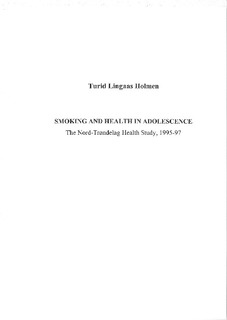| dc.contributor.author | Holmen, Turid Lingaas | nb_NO |
| dc.date.accessioned | 2014-12-19T14:22:28Z | |
| dc.date.available | 2014-12-19T14:22:28Z | |
| dc.date.created | 2001-08-31 | nb_NO |
| dc.date.issued | 2001 | nb_NO |
| dc.identifier | 125226 | nb_NO |
| dc.identifier.uri | http://hdl.handle.net/11250/264380 | |
| dc.description.abstract | The onset of cigarette smoking begins primarily in adolescence, and prevalence of smoking among adolescents has been increased during the last ten years. The prevalence of adolescent smoking increases with age and is more common or at least as common in girls as in boys in most western countries.
Until recently the intensive investigation on health effects of smoking has been mostly conducted among adults. In adolescence the long-term health consequences have been reviewed, but current health problems are probably more important to adolescents and may be more motivating for smoking prevention and cessation. Increased morbidity among adolescent smokers has been reported, but specific current health problems and medication use have received little attention. More
Control of smoking is a primary health goal. An underlying premise for promotion of physical activity in adolescence is that it may mead to a healthy lifestyle persisting through adulthood. Encouraging participation in sports has been recommended as smoking prevention and as part of smoking cessation programs. Smoking habits within different types of sports has received less attention, and whether physical activity has an impact on lung function is debated.
Adolescent smokers are often unsuccessful in quitting and difficult to recruit and retain in smoking cessation programs. Occasional smoking may be the strongest risk factor for daily smoking, but occasional smokers could be an important target group for smoking cessation who could be discouraged from moving into daily smoking status.
The first aim of this thesis was to study associations between smoking and current health status by examining associations between daily smoking and subjective health problems (Paper 1), and gender specific effects on respiratory symptoms and lung function (Paper II). The associations between physical activity and lung function in never smokers and daily smokers were also assessed (Paper III). The second aim was to study factors that might be useful in smoking | nb_NO |
| dc.language | eng | nb_NO |
| dc.publisher | Det medisinske fakultet | nb_NO |
| dc.relation.ispartofseries | Dissertations at the Faculty of Medicine, 0805-7680; 190 | nb_NO |
| dc.subject | Medicine | en_GB |
| dc.subject | Adolescent | en_GB |
| dc.subject | health | en_GB |
| dc.subject | smoking | en_GB |
| dc.subject | smoking-epidemiology | en_GB |
| dc.subject | MEDICINE: Dermatology and venerology,clinical genetics, internal medicine | en_GB |
| dc.title | Smoking and health in adolescence : The Nord-Trøndelag Health Study, 1995-1997 | nb_NO |
| dc.type | Doctoral thesis | nb_NO |
| dc.contributor.department | Norges teknisk-naturvitenskapelige universitet, Det medisinske fakultet, Institutt for samfunnsmedisin | nb_NO |
| dc.description.degree | dr.med. | nb_NO |
| dc.description.degree | dr.med. | en_GB |
